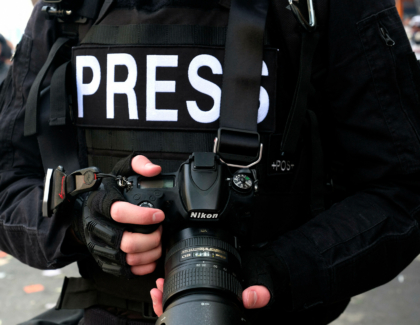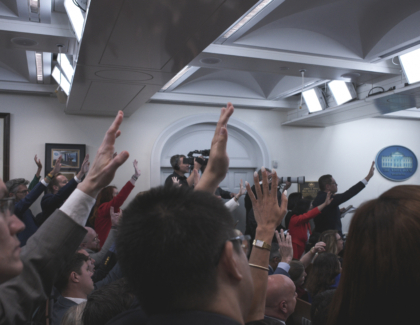Sign up for the daily CJR newsletter.
A DECADE OR SO AGO, when the Philadelphia Inquirer and Daily News had no strong digital presence, and their parent company was in the early stages of a bruising saga of ownership disputes, bankruptcy, and layoffs, Philly.com was dominated by the kind of lurid, clickable content that serves a business model based on digital advertising. At the time, the three brands were owned in common and managed separately. And while Philly.com published stories from the two newspapers, its prevailing mission was distinct from theirs. So when the three newsrooms merged two years ago, around the time that owner Gerry Lenfest donated the company to a new nonprofit foundation, a rethinking of the digital operation was long overdue.
Last month, Philly.com—the website that publishes stories from the city’s two remaining dailies, the Inquirer and Daily News—began selling digital subscriptions and limiting access to 10 free articles per month. Users who sign up for a digital subscription will pay $0.99 for the first four weeks of access, and $2.99 a week thereafter. A digital subscription also now comes standard with home delivery of the Inquirer, and promises some premium content that nonsubscribers can’t access.
A revolutionary experiment for the digital age it is not. As of the summer of 2015, at least three quarters of the biggest newspaper companies in the United States were using some type of digital subscription model, according to the American Press Institute. And Philadelphia Media Network, which owns the Inquirer, Daily News, and Philly.com, has been promising that a meter was coming since at least two years ago, when PMN merged its three newsrooms amid a round of layoffs.
But the company’s basic subscription model masks complicated changes taking place behind the scenes. PMN began overhauling its newsroom this past spring as part of an effort to win over a critical mass of digital subscribers. More than 200 journalists reapplied for their jobs, and the news organization conceived a new set of beats meant to align its reporting with what it expects will interest modern audiences.
The company also has taken steps to remake Philly.com as a fitting platform for the newspapers’ journalism and a web product worth paying for—which, not so long ago, would have been unthinkable.
There was a sense not only that the website needed improvements but that the company’s whole approach to news should be refreshed, company executives and newsroom leaders tell CJR
“WE KNEW THAT IN THE NOT-TOO-DISTANT FUTURE we would be putting up a meter and asking people to pay, and that there was a disconnect between the expectation that a lot of people would do that and what we were like, editorially, at the time,” says Patrick Kerkstra, the newsroom’s managing editor for digital content and a former Inquirer reporter who was hired back last year after a stint as editor of Philadelphia magazine.
“We wanted to de-emphasize commodity content that you could find at any number of local websites for free, and that you would continue to find for free after our meter went up,” says Kerkstra. (Full disclosure: I have worked with Kerkstra and consider him a friend. I have also freelanced for PMN on occasion.)
There was a sense not only that the website needed improvements but that the company’s whole approach to news should be refreshed, company executives and newsroom leaders tell CJR. The traditional practice of assigning reporters to geographical beats, or providing incremental coverage of municipal politics, wasn’t going to serve the digital audience PMN hoped to attract. So the company has tried to reorganize the newsroom thematically, to get at stories that would attract a cross-section of its coverage area.
I know what a terrible reputation this commenting community has. I’m hoping to play a role in making it less toxic, and making it a place where people feel like there is actually constructive dialogue, where people are making connections.
“Our readership has to reflect the region, and it doesn’t,” says Gabriel Escobar, editor of the combined newsroom—whose demographics, it should also be noted, do not reflect the diversity of the region. “We have loyal readers. We have avid readers. We want loyal and avid readers in greater numbers, but we also want representative readership of the region, and it isn’t there. And it isn’t there for complicated reasons.”
It’s not surprising that print subscribers tend to be older, but the readership on Philly.com is older and more male than the region as well, according to Kim Fox, the managing editor for audience. Readers have complained about the user experience on Philly.com for a long time—a Philadelphia magazine writer once described it as “a cluttered, unattractive afterthought”—and the animated digital ads on its articles were disruptive long before news readers everywhere came to expect those kinds of distractions.
But nothing hangs on the Philly.com brand as heavily as the long-unmoderated comments section, which has earned its notoriety as the Delaware Valley’s premier hangout for racist web trolls.
“I know what a terrible reputation this commenting community has,” Fox says. “I’m hoping to play a role in making it less toxic, and making it a place where people feel like there is actually constructive dialogue, where people are making connections.”
The subscription meter—don’t call it a “paywall,” as Jim Friedlich, CEO of the Lenfest Institute, which owns the company, gently admonished me—has cut down on the comments section’s most egregious back-and-forth shitposting by limiting the amount of commentary a nonsubscriber can post, Fox says. But it’s also curtailed web traffic more significantly than the company anticipated: pageviews were down 27 percent in the month after the meter went up, newsroom leaders confirmed. On the other hand, around 9,000 new digital subscribers have joined in the same period, outpacing their early targets by a factor of four.
Executive Editor Stan Wischnowski told me that, long term, the company hopes to rival the Boston Globe for digital subscriptions; the Globe has more than any other regional paper in the country, with around 85,000. To get there, PMN is pushing to improve its digital products, with a series of new email newsletters—a politics dispatch called Trumpadelphia, for example, and a weekly roundup of food news and restaurant criticism—along with an expansion of the online opinion section, more experimentation with topical events, and some ambitious forays into civic convening.
“One of the things we’ve tried to do is ‘quality over quantity’ all across the board,” says Fox. “Our job is to make sure that the best journalism gets as many eyes as possible … It’s really easy to throw up links all day long, but we’re starting to think about making sure that we’re sharing our best journalism at the best times with the best people in a more focused way.”
That’s something of a sea change for Philly.com, and all the reporters I spoke to in the newsroom seem to welcome it. But even a revolution in digital quality can’t answer a few fundamental questions about the company’s future.
PHILADELPHIA MEDIA NETWORK IS THE UMBRELLA for three different brands: the Inquirer, Daily News, and Philly.com. Historically, the three newsrooms were competitive—“with a sprinkling of antagonism, depending on when you peeked under the curtain,” Escobar says—and each product has its own associated strengths and weaknesses. Even though the newsroom merger has gone more smoothly than many expected, there’s still the question of what, specifically, the company is asking subscribers to pay for.
The company is increasingly leaning on the Inquirer as its lead brand—the Inquirer flag now sits higher and larger than either of the other logos on the website—and executives acknowledged that that’s likely to continue. There have been discussions about moving to an Inquirer.com URL, but newsroom leaders won’t say when exactly that might happen. And nobody seems to know what that would mean for Philly.com—which, as several reporters noted, rolls off the tongue a little more smoothly. (Under previous ownership, the company experimented with separate websites for each product, but the Inquirer and Daily News were both paywalled, while Philly.com kept publishing most of the stories from both papers for free, and the whole thing flamed out rather quickly. “It was not well executed, and we would never return to something like that,” Wischnowski tells me.)
The other big question is the same one that all newsrooms face: How to make a dollar?
In PMN’s case, it really is only a dollar, as publisher Terry Egger has said numerous times. The last ownership dispute at the papers was settled in 2014, when Gerry Lenfest, an 87-year-old philanthropist and former cable-TV mogul, won a bid for the company, in partnership with fellow businessman Lewis Katz. Katz died in a plane crash just days after the auction, and Lenfest later donated the papers to a new nonprofit foundation, which he also endowed with $20 million to invest in both PMN and the news ecosystem around the city. The Lenfest Institute announced its first round of investments in mid-September, with $1 million dedicated to new initiatives at PMN and another $1 million going to outside efforts. The grants to PMN will go toward investigative news, digital improvements, and fellowships for reporters from diverse backgrounds.
Even after the buyout announcement, reporters seemed slightly warmed by the fact that this time, new hires focused on the digital side are being announced alongside the cuts. It’s bad news seasoned with some half-decent news.
The nonprofit ownership structure has taken the pressure off the company to turn profits and in some ways improved morale among reporters, whose labor is no longer being used to shore up a hedge fund or enrich a wealthy tycoon. But it has done nothing to solve the underlying crisis: Advertising revenue is still falling fast enough that even a perpetually downsized newsroom with no profit imperative is not stable yet. And there is a strong sense across the newsroom that any attempt to restructure beats and rebrand the product is superficial without more meaningful efforts to create a more diverse editorial staff.
Even with the infusion of Lenfest grants, the company can’t make the investments it wants to make without cutting back somewhere else, says publisher Terry Egger.
“I think we’ll have a little bit more rough stuff,” Egger says, “because the plans that are in the works now do call for some areas we need to invest and some areas we may need to disinvest, cut back.”
THE ROUGHT STUFF DROPPED two weeks after we spoke. In early October, a memo signed by Wischnowski, Escobar, and Kerkstra went out to the newsroom, announcing another round of buyouts. The company is hoping 30 to 35 newsroom employees will take the buyout—“the last best chance for staffers considering a life change, retirement or different career,” they wrote—or else there will be layoffs. Unlike some previous buyout offers, virtually everyone in the newsroom is eligible, not just those who have reached a certain age or length of employment. The cuts are targeted at the copy desk, with plans to eliminate at least two job categories in the process.
“Hard choices … must be made as we grapple with the economic realities and the changing nature of our industry,” the memo says, in language that must ring painfully familiar to anyone who’s read a newsroom memo in the past dozen years. “We have an editing and print production structure that can no longer effectively serve our changing needs. And we have some reporters, columnists and editors who have not adapted to the demands of digital publishing.”
The reporters I spoke with said the buyout offer—the scale of it, in particular—took the newsroom by surprise. Like any staff reduction, it’s demoralizing. People are anxious. Howard Gensler, president of the Newspaper Guild Local 10, said he had no idea it was coming until the morning it was announced.
“When you have a lot of managers whose jobs depend on reorganization and declaring victory over everything, you get a lot of memos saying how great things are,” Gensler said. “And then you get a memo a week later saying, ‘We’ve gotta reduce the staff by 35 people.’”
Asked whether he accepts the framing of the current buyout—part of a digital investment strategy, rather than a simple cost-cutting measure—Gensler replied, “I bet they think that. Everybody’s got to look at themselves in the mirror.”
So PMN is not out of the woods—and it may never be, so long as print advertising provides a substantial piece of its revenue. (It’s still cheapest to get unlimited digital access by subscribing to the Sunday Inquirer, presumably to keep its circulation numbers up.) But even after the buyout announcement, reporters seemed slightly warmed by the fact that this time, new hires focused on the digital side are being announced alongside the cuts. It’s bad news seasoned with some half-decent news, which may count as a small miracle in a newsroom accustomed to bad on bad. And everyone CJR talked to for this story said that if nothing else, the ownership structure feels stable, which could give the company a chance to catch up.
“We were starting from way behind, and there were a couple of contributing factors,” said Escobar. “The primary one is that we were three, that there was dysfunctional ownership history, conflict. When you have that as your daily reality, the greatest impact is that you cannot plan. You can’t be strategic. You can’t be current. You can’t constantly assess what others are doing and what you should be doing.”
One byproduct of the recent changes is that the company seems to be integrating with the rest of the local journalism community in a way it could never manage to do before. Ever since the digital crisis began, journalists and funders have been brooding over how to foster a news ecosystem in Philadelphia that can sustain itself financially while serving the public interest. The problem they were hoping to address, in some ways, was PMN itself: the Inquirer and Daily News were shedding staff continuously and competing with each other in all the wrong ways, while Philly.com was busy chasing whatever pageviews it could find. Experiments to fill the journalistic gaps have been varied. Some have failed, while others, like Billy Penn, the Philadelphia Citizen, and a small network of niche sites, are still trying to figure it out.
It would be glib to suggest that Philly.com is now poised to lead the city into a new golden age of digital journalism. But for the first time in many years, maybe ever, it looks like it could at least be part of the solution.
Has America ever needed a media defender more than now? Help us by joining CJR today.







